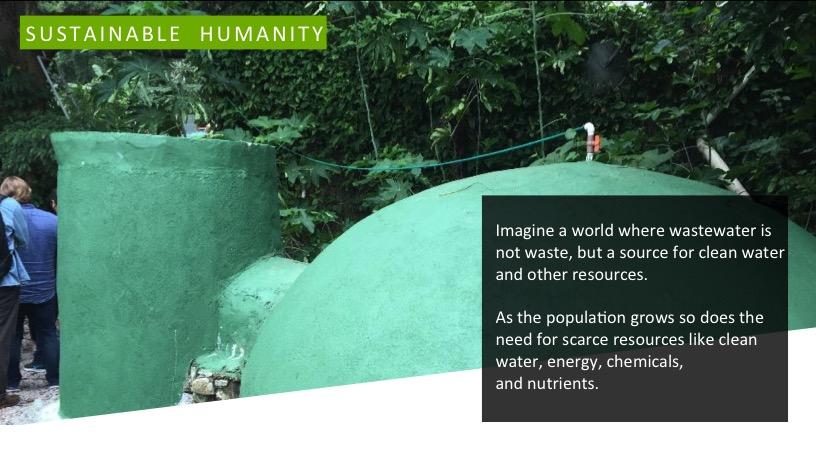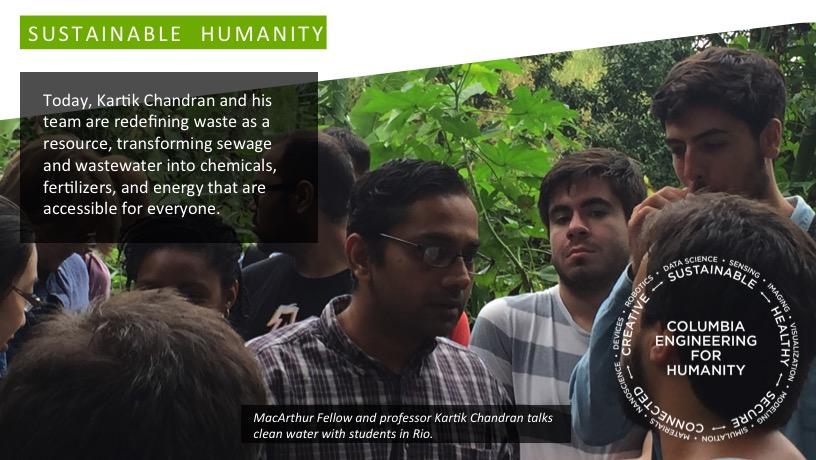Kartik Chandran
PROFESSOR OF EARTH AND ENVIRONMENTAL ENGINEERING
1045 S.W. Mudd
Mail Code 4711
Kartik Chandran is a global leader in sustainable wastewater treatment and engineered resource recovery. Chandran’s work is enabled through understanding and harnessing the biochemical potential and metabolism of microbial communities and developing appropriate technologies towards addressing global environmental and societal needs.
Research Interests
Engineered systems for resource recovery, microbial N- cycling, sustainable sanitation and wastewater treatment, global climate impacts of engineered wastewater treatment practice, microbial ecology of engineered biological waste and water treatment, reactors, novel molecular based biokinetic estimation tools, elucidation of microbial biochemical degradation pathways , bioprocess modeling and parameter identification for complex biotransformations.His fundamental work has focused on elucidating the molecular mechanisms and pathways of the microbial nitrogen cycle and its links to the global carbon, water and energy cycles. His applied work ranges from large-scale centralized wastewater treatment systems to community scale decentralized resource recovery systems and technologies across the globe.
The key insight of Chandran’s research and applications thereof is that certain combinations of mixed microbial communities, similar to those that occur naturally, can be used to mitigate the harmful environmental impacts of wastewater and to extract useful products. This approach also involves reduced chemical and energy inputs relative to traditional treatments and has the added benefit of preventing algal blooms downstream by maximizing nitrogen removal. More recently, using ammonia-oxidizing bacteria, Chandran has enabled the transformation of bio-generated methane gas into methanol, a chemical that is both easily transported and widely useful in industry (including in the wastewater industry).
Chandran imaginatively tailors his solutions to be locally appropriate. In rural Ghana, in conjunction with his Engineers without Borders students, he has re-engineered source-separation toilets to both provide sanitation and recover nutrients for use in agriculture. In Kumasi, Ghana, he has tested the large-scale conversion of sludge into biofuel while also providing new training opportunities for local engineers and managers. Through his groundbreaking research and its practical applications, Chandran is demonstrating the hidden value of wastewater, conserving vital resources, and protecting public health.
Chandran received his B.E. in Chemical Engineering from the Indian Institute of Technology, Roorkee (formerly the University of Roorkee) in 1995 and his Ph.D. in Environmental Engineering from the University of Connecticut in 1999. He received a MacArthur Foundation Fellowship in 2015 and was named a Fellow of the Water Environment Federation in 2013.


RESEARCH EXPERIENCE
- Research Associate, Virginia Polytechnic Institute and State University, 2004-2005
- Postdoctoral fellow, University of Connecticut, 1999-2001
PROFESSIONAL EXPERIENCE
- Professor of Earth and Environmental Engineering, 2016 – to date
- Associate Professor of Earth and Environmental Engineering, 2011 - 2015
- Assistant Professor of Earth and Environmental Engineering, 2005 – 2010
- Senior Engineer and Technical Specialist, Metcalf and Eddy, AECOM, 2001 - 2005
PROFESSIONAL AFFILIATIONS
- Water Environment Federation
- American Society for Microbiology
HONORS & AWARDS
- MacArthur Foundation Fellow, 2015
- WEF Camp Applied Research Award, 2016
- Visiting Professor, Royal Dutch Academy of Arts and Sciences (2014)
- WE&RF Paul Busch Award, 2010
- NSF CAREER Award, 2009
SELECTED PUBLICATIONS
- Park, M-R., Park, H., K. Chandran*. 2017. Molecular and kinetic characterization of planktonic Nitrospira spp. selectively enriched from activated sludge. Environmental Science and Technology 51(5): 2720-2728.
- Park, H., Brotto, A. C., van Loosdrecht, M. C. M., K. Chandran*. 2017. Discovery and metagenomic analysis of an anammox bacterial enrichment related to Candidatus “Brocadia caroliniensis” in a full-scale glycerol-fed nitritation-denitritation separate centrate treatment process. Water Research 11: 265-273.
- Vajpeyi, S., K Chandran*. 2016. Draft genome sequence of the oleaginous yeast Cryptococcus albidus var. albidus. Genome announcements 4 (3), e00390-16.
- Vajpeyi, S., K Chandran*, 2015, “Microbial conversion of synthetic and food waste-derived volatile fatty acids to lipids”, Bioresource technology 188, 49-55
- Khunjar, W.*, D. Jiang, B. Wett, S. Murthy and K. Chandran*, 2015 “Characterizing the metabolic tradeoff in Nitrosomonas europaea in response to changes in inorganic carbon supply”, Environmental Science and Technology, 2015, 49 (4), pp 2523–2531
- Brotto, A. C., H. Li, M. Dumit, J. Gabarro, J. Colprim, S. Murthy and K Chandran*, 2015, Characterization and mitigation of nitrous oxide (N2O) emissions from partial and full‐nitrification BNR processes based on post‐anoxic aeration control, Biotechnology and bioengineering, 112(11), pp 2241-2247, DOI: 10.1002/bit.25635
- Ma, Y., S. Sundar, H. Park, and K. Chandran*, 2015, “The effect of inorganic carbon on microbial interactions in a biofilm nitritation-anammox process”, Water Research, 70, pp 246-254
- Park, H., S. Sundar, Y. Ma and K. Chandran*, 2015 “Differentiation in the microbial ecology and activity of suspended and attached bacteria in a nitritation anammox process”, Biotechnology and Bioengineering, 112(2), 272-279
- Lu, H., K. Chandran*, H. D. Stensel, 2014 “Microbial ecology of denitrification in biological wastewater treatment”, Water Research, 64, 237-254
- Lu, H. M. Kalyuzhnaya and K. Chandran*, 2012 “Comparative proteomic and transcriptional analysis reveal insights into facultative methylotrophy of Methyloversatilis universalis FAM5*”, Environmental Microbiology, 14(11), 2935-2945.
- Ahn, J.-H., S. Kim, H. Park, K. Pagilla and K. Chandran*, 2010 “N2O emissions from activated sludge 2008-2009: Results of a nationwide monitoring survey in the United States” Environmental Science and Technology, 44(12), 4505-4511.
- Yu, R., M. Kampschreur, M. C. M. van Loosdrecht and K. Chandran*, 2010 “Mechanisms and specific directionality in autotrophic nitrous oxide and nitric oxide generation during transient anoxia” Environmental Science and Technology, 44(4), 1313-1319.
